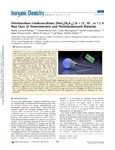Mostrar o rexistro simple do ítem
Diimidazolium Halobismuthates [Dim]2[Bi2X10] (X = Cl–, Br–, or I–): A New Class of Thermochromic and Photoluminescent Materials
| dc.contributor.author | García-Fernández, Alberto | |
| dc.contributor.author | Marcos-Cives, Ismael | |
| dc.contributor.author | Platas-Iglesias, Carlos | |
| dc.contributor.author | Castro-García, Socorro | |
| dc.contributor.author | Vázquez, Digna | |
| dc.contributor.author | Fernández, Alberto | |
| dc.contributor.author | Sánchez-Andújar, Manuel | |
| dc.date.accessioned | 2024-01-19T19:57:17Z | |
| dc.date.issued | 2018-06-12 | |
| dc.identifier.citation | García-Fernández, A., Marcos-Cives, I., Platas-Iglesias, C., Castro-García, S., Vázquez-García, D., Fernández, A., & Sánchez-Andújar, M. (2018). Diimidazolium Halobismuthates [Dim]2[Bi2X10] (X = Cl–, Br–, or I–): A New Class of Thermochromic and Photoluminescent Materials. Inorganic Chemistry, 57(13), 7655-7664. https://doi.org/10.1021/acs.inorgchem.8b00629 | es_ES |
| dc.identifier.issn | 1520-510X | |
| dc.identifier.uri | http://hdl.handle.net/2183/35025 | |
| dc.description.abstract | [Abstract] We present a novel family of polyhalide salts of Bi(III) with the general formula [Dim]2[Bi2X10], where Dim2+ is the diimidazolium cation (C9H14N4)2+ and X is Cl–, Br–, or I–. Single-phase materials are easily obtained by means of a mild solution chemistry method performed at room temperature. This [Dim]2[Bi2X10] family exhibits a crystal structure based on halobismuthate [Bi2X10]4– dimers, built by distorted {BiX6} octahedra interconnected by edge sharing, and sandwiched between two diimidazolium cations. The optical band gaps displayed by these materials (1.9–3.2 eV) allow their classification as semiconductors. Additionally, the three halides display photoluminescence with emission in the visible range. The behavior of [Dim]2[Bi2I10] is particularly interesting, as it shows an optical band gap of 1.9 eV, a broad band photoluminescence emission, and a relatively long emission lifetime of 190 ns. Moreover, the iodide and bromide compounds also exhibit a reversible solid state thermochromism, being the first example of a bromobismuthate with this property. The diimidazolium cations play an important structural role by stabilizing the crystal structure and balancing the charges of the [Bi2X10]4– dimers. Furthermore, density functional theory calculations suggest that they play a key role in the thermochromic behavior. Therefore, compounds [Dim]2[Bi2X10] (X = Cl–, Br–, or I–) represent a very versatile family in which the optical band gap can be tuned by changing the halide or temperature. This makes them promising new materials for different optoelectronic applications, in particular for obtaining new solar absorbers. | es_ES |
| dc.description.sponsorship | The authors acknowledge financial support of Ministerio de Economía y Competitividad (MINECO) and EU-FEDER (ENE2014-56237-C4-4-R) and Xunta de Galicia (GRC2014/042). C.-P.-I. thanks Centro de Supercomputación de Galicia (CESGA) for providing the computer facilities. I. M. thanks fundación Segundo Gil Davila for financial support | es_ES |
| dc.description.sponsorship | Xunta de Galicia; GRC2014/042 | es_ES |
| dc.language.iso | eng | es_ES |
| dc.publisher | American Chemical Society (ACS) | es_ES |
| dc.relation | info:eu-repo/grantAgreement/MINECO/Plan Estatal de Investigación Científica y Técnica y de Innovación 2013-2016/ENE2014-56237-C4-4-R/ES/MATERIALES EMERGENTES PARA CELDAS SOLARES DE BAJO COSTE EN CONFIGURACION TANDEM/ | es_ES |
| dc.relation.uri | https://doi.org/10.1021/acs.inorgchem.8b00629 | es_ES |
| dc.rights | © 2018 American Chemical Society | es_ES |
| dc.subject | Anions | es_ES |
| dc.subject | Cations | es_ES |
| dc.subject | Electrical conductivity | es_ES |
| dc.subject | Halogens | es_ES |
| dc.subject | Inorganic compounds | es_ES |
| dc.title | Diimidazolium Halobismuthates [Dim]2[Bi2X10] (X = Cl–, Br–, or I–): A New Class of Thermochromic and Photoluminescent Materials | es_ES |
| dc.type | info:eu-repo/semantics/article | es_ES |
| dc.rights.access | info:eu-repo/semantics/embargoedAccess | es_ES |
| dc.date.embargoEndDate | 9999-99-99 | es_ES |
| dc.date.embargoLift | 9999-99-99 | |
| UDC.journalTitle | Inorganic Chemistry | es_ES |
| UDC.volume | 57 (2018) | es_ES |
| UDC.issue | 13 | es_ES |
| UDC.startPage | 7655 | es_ES |
| UDC.endPage | 7664 | es_ES |
| dc.identifier.doi | 10.1021/acs.inorgchem.8b00629 |
Ficheiros no ítem
Este ítem aparece na(s) seguinte(s) colección(s)
-
GI- Quimolmat - Artigos [104]
-
GI-REACT! - Artigos [113]






